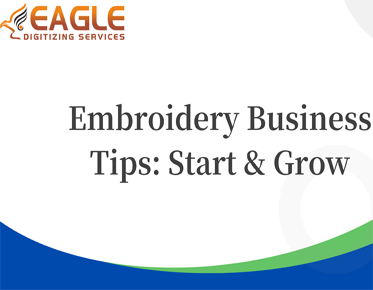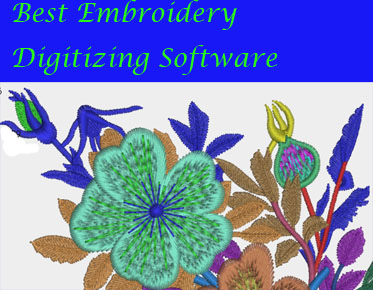Embroidery Business 101: Tips for Starting and Growing Your Own Venture
Introduction
Embroidery, once considered a traditional craft, has evolved into a thriving business opportunity in various industries. Whether it's adding personalized touches to clothing or branding corporate merchandise, embroidery businesses play a significant role in today's market. This guide provides essential tips for those looking to start their own embroidery venture and offers insights for those seeking to grow their existing business.
Market Research
Identifying
target market
Before diving into the embroidery business, it's crucial to identify your target market. Understand who your potential customers are, whether they're individuals seeking customized gifts or businesses in need of branded apparel. By pinpointing your audience, you can tailor your products and services to meet their specific needs and preferences.
Analyzing
competition
Conduct thorough research on your competitors to understand the landscape of the embroidery market. Analyze their strengths and weaknesses, pricing strategies, and customer base. Identifying gaps in the market can help you carve out a unique selling proposition for your business and differentiate yourself from the competition.
Understanding
industry trends
Stay abreast of the latest trends in the embroidery industry, including design preferences, technology advancements, and consumer behavior. Whether it's incorporating eco-friendly materials or embracing digital embroidery techniques, staying ahead of trends can give your business a competitive edge and attract discerning customers.
Business Planning
Creating
a business plan
A well-crafted business plan serves as a roadmap for your embroidery venture. Outline your business goals, target market, competitive analysis, and marketing strategies. A clear plan will not only guide your business decisions but also serve as a valuable tool when seeking funding or partnerships.
Setting
goals and objectives
Set realistic and measurable goals for your embroidery business. Whether it's achieving a certain level of sales revenue within the first year or expanding your client base by a certain percentage, setting clear objectives will help you stay focused and motivated as you work toward success.
Budgeting
and financial planning
Financial planning is essential for the sustainability of your embroidery business. Calculate your startup costs, including equipment, supplies, and marketing expenses. Develop a budget for ongoing operational costs and project your revenue streams to ensure profitability. Keeping a close eye on your finances from the outset will help you make informed decisions and avoid financial pitfalls down the road.
Legal Considerations
Registering
your business
Before launching your embroidery venture, ensure that you comply with all legal requirements for operating a business in your jurisdiction. Choose a suitable business structure, such as sole proprietorship, partnership, or LLC, and register your business with the appropriate authorities.
Obtaining
necessary permits and licenses
Depending on your location and the nature of your embroidery business, you may need to obtain permits or licenses to operate legally. Research local regulations governing home-based businesses, zoning laws, and health and safety requirements to ensure compliance.
Understanding
tax obligations
Navigating the tax landscape can be daunting for new business owners. Consult with a tax professional to understand your tax obligations, including income tax, sales tax, and payroll tax. Implement systems for record-keeping and tax filing to stay organized and avoid penalties.
Sourcing Equipment and Supplies
Embroidery
machines
Investing in high-quality embroidery machines is essential for producing professional-looking embroidery designs. Consider factors such as stitching speed, hoop size, and compatibility with digitizing software when choosing a machine that suits your business needs.
Thread,
needles, and other supplies
Source embroidery supplies from reputable suppliers to ensure consistent quality in your finished products. Stock up on a variety of thread colors, needles, stabilizers, and backing materials to accommodate different design requirements and customer preferences.
Software
for digitizing designs
Digitizing software allows you to convert digital artwork into embroidery files that can be stitched out by your embroidery machine. Choose software that is user-friendly and compatible with your machine model, and invest time in learning how to use it effectively to achieve the best results.
Design and Digitization
Creating
original designs
Developing unique and eye-catching embroidery designs is key to attracting customers and setting your business apart from competitors. Experiment with different design styles, motifs, and color combinations to create a diverse portfolio of designs that appeal to a wide range of tastes.
Digitizing
designs for embroidery machines
Embroidery digitizing is the process of converting artwork or images into a format that can be stitched out by an embroidery machine. Invest in digitizing software and take the time to learn how to use it properly, or outsource digitizing services to professionals if you're not comfortable doing it yourself.
Customization
options for clients
Offering customization services allows you to cater to individual customer preferences and create personalized embroidery designs. Whether it's adding monograms, logos, or custom text to garments and accessories, providing customization options can enhance the value of your products and attract customers seeking unique, one-of-a-kind items.
Setting Up Your Workspace
Choosing
a suitable location
Selecting the right workspace for your embroidery business is essential for productivity and efficiency. Whether you operate from a dedicated studio space, a home-based setup, or a commercial storefront, choose a location that offers ample space, good lighting, and easy access for clients and deliveries.
Organizing
your workspace efficiently
Optimize your workspace layout to streamline your embroidery workflow and minimize distractions. Arrange your equipment and supplies in a logical order, designate areas for design work, embroidery production, and finishing, and invest in storage solutions to keep your workspace organized and clutter-free.
Ensuring
safety and cleanliness
Maintaining a clean and safe working environment is crucial for the health and well-being of you and your employees. Regularly clean and maintain your embroidery equipment to prevent dust buildup and ensure optimal performance. Implement safety measures such as fire extinguishers, first aid kits, and ergonomic workstations to minimize the risk of accidents or injuries.
Marketing and Branding
Developing
a brand identity
Building a strong brand identity is essential for establishing your embroidery business in the marketplace and attracting customers. Define your brand values, personality, and unique selling propositions, and communicate them consistently across all marketing channels and touchpoints.
Online
and offline marketing strategies
Utilize a mix of online and offline marketing tactics to promote your embroidery business and reach potential customers. Establish a professional website showcasing your portfolio, services, and contact information, and leverage social media platforms to engage with your audience and showcase your work. Explore traditional marketing channels such as print advertising, direct mail, and networking events to expand your reach and attract local customers.
Building
relationships with clients and suppliers
Fostering strong relationships with your clients and suppliers is key to the success of your embroidery business. Provide excellent customer service, communicate promptly and professionally, and deliver high-quality products that exceed expectations to build trust and loyalty with your clients. Cultivate relationships with reliable suppliers who offer competitive pricing, quality products, and timely delivery to ensure the smooth operation of your business.
Pricing Strategy
Calculating
costs
Determine the costs associated with running your embroidery business, including equipment, supplies, labor, overhead, and other expenses. Calculate your production costs for each embroidery project, taking into account materials used, machine time, and labor costs to ensure that your pricing covers your expenses and generates a reasonable profit margin.
Setting
competitive prices
Research market prices for embroidery services in your area and industry to gauge the going rate for similar services. Consider factors such as your level of expertise, the complexity of the design, and the quality of materials used when determining your pricing. Set competitive prices that reflect the value you provide to your customers while remaining profitable and sustainable for your business.
Offering
discounts and promotions
Attract new customers and encourage repeat business by offering discounts, promotions, or special offers on your embroidery services. Consider running seasonal promotions, offering package deals, or providing loyalty rewards to incentivize customers to choose your business over competitors. Communicate your promotions effectively through your website, social media, and email marketing campaigns to generate interest and drive sales.
Customer Service
Providing
excellent service
Deliver exceptional customer service at every touchpoint of the customer journey, from initial inquiry to final delivery. Be responsive, friendly, and helpful in your communications with clients, and strive to exceed their expectations with timely delivery, attention to detail, and personalized service.
Handling
customer inquiries and complaints
Address customer inquiries and concerns promptly and professionally to resolve issues and maintain customer satisfaction. Listen actively to customer feedback, take responsibility for any mistakes or errors, and work proactively to find solutions that meet the customer's needs and expectations.
Building
long-term relationships with clients
Focus on building long-term relationships with your clients based on trust, reliability, and mutual respect. Stay in regular contact with clients through email newsletters, social media updates, and personalized follow-ups to keep them engaged and informed about your latest offerings and promotions. Provide value-added services such as design consultations, product recommendations, and exclusive discounts to reward loyal customers and encourage repeat business.
Managing Operations
Scheduling
production
Develop a production schedule to manage workflow efficiently and ensure timely delivery of embroidery projects. Prioritize orders based on deadlines, complexity, and client preferences, and allocate resources such as machine time and labor accordingly to maximize productivity and minimize turnaround times.
Inventory
management
Monitor your inventory levels regularly and reorder supplies as needed to avoid stockouts and delays in production. Keep accurate records of inventory quantities, usage rates, and reorder points to ensure that you always have the materials on hand to fulfill customer orders and maintain smooth operations.
Quality
control
Implement rigorous quality control measures to ensure that every embroidery project meets your high standards of craftsmanship and exceeds customer expectations. Inspect finished products for defects, errors, or inconsistencies before delivery, and make any necessary adjustments or repairs to ensure that the final product is flawless and ready for use.
Scaling Your Business
Hiring
employees
As your embroidery business grows, consider hiring additional staff to help you manage increased demand and expand your capacity. Look for employees with relevant skills and experience in embroidery, machine operation, and customer service, and provide training and support to help them succeed in their roles.
Expanding
product offerings
Diversify your product offerings to appeal to a broader range of customers and capitalize on new market opportunities. Consider expanding into related product categories such as screen printing, heat transfer, or custom apparel design, or offering additional services such as embroidery digitizing, monogramming, or garment finishing to meet evolving customer needs.
Exploring
new markets
Explore new geographic regions or industry verticals to expand your customer base and grow your business. Research market trends, consumer preferences, and competitive landscapes in potential target markets, and develop targeted marketing and sales strategies to penetrate new territories and acquire new customers.
Challenges and Solutions
Dealing
with competition
Stay competitive in the embroidery market by offering unique products, exceptional service, and innovative solutions that differentiate your business from competitors. Keep abreast of industry trends, invest in ongoing training and education, and continuously innovate and adapt to meet changing customer needs and preferences.
Adapting
to industry changes
The embroidery industry is constantly evolving, with new technologies, design trends, and consumer preferences emerging regularly. Stay flexible and adaptable to changes in the market, embrace new technologies and techniques, and be proactive in exploring opportunities for growth and innovation to stay ahead of the curve and maintain your competitive edge.
Overcoming
financial obstacles
Running a successful embroidery business requires careful financial management and planning to ensure profitability and sustainability. Keep a close eye on your finances, track expenses and revenue diligently, and adjust your budget and pricing strategies as needed to maintain profitability and weather financial challenges such as seasonal fluctuations, economic downturns, or unexpected expenses. Consider seeking guidance from financial advisors or business mentors to help you navigate financial obstacles and make informed decisions about the future of your business.
Conclusion
Starting and growing an embroidery business
requires careful planning, strategic decision-making, and a commitment to
excellence in every aspect of your operations. By following the tips outlined
in this guide and staying focused on delivering quality products, exceptional
service, and value to your customers, you can build a successful and
sustainable embroidery venture that stands the test of time.



